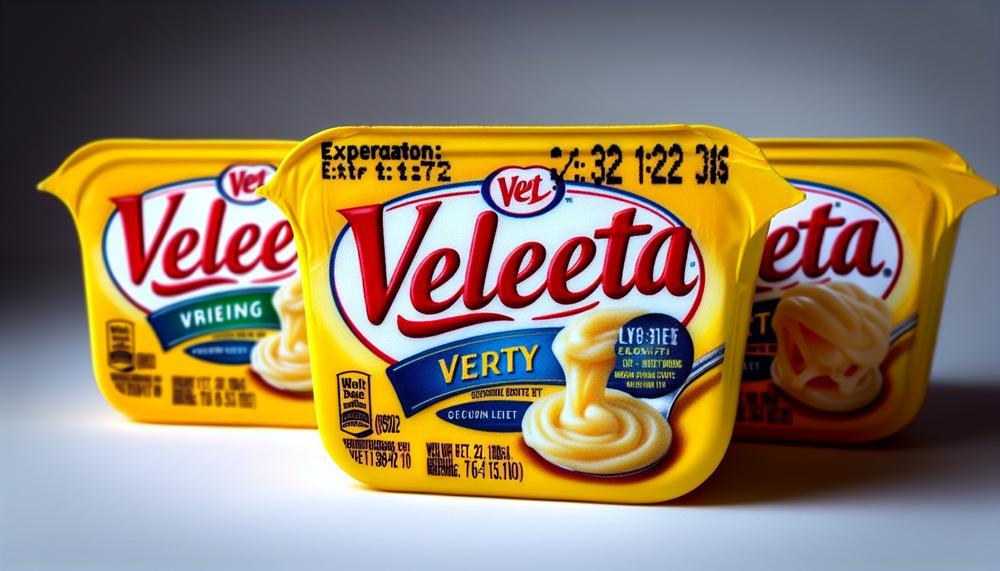Did you know that Velveeta cheese can safely be consumed for up to six months past its expiration date? That’s right, this popular processed cheese product has a surprisingly long shelf life. Whether you’re a fan of creamy mac and cheese or gooey cheese dip, it’s important to understand how to assess the quality and safety of Velveeta as it approaches or surpasses its expiration date.
So, Is Velveeta good past the expiration date?
An unopened box of Velveeta cheese can be safe to eat up to six months past its expiration date if stored in its original packaging, in a dry place, out of sunlight, and at room temperature. However, the best-by date on Velveeta packaging is more about quality than safety. Velveeta may be safe to eat after this date but may not be at its best quality.
Before consuming post-expiry, it’s important to inspect for spoilage signs. Signs of spoilage include changes in color and consistency, odd smells, and possibility of mold.
After opening, Velveeta can last about six months if kept in a dry place at room temperature and away from sources of heat.
Contents
Key Takeaways:
- Velveeta can be consumed safely for up to six months past its packaging date.
- Proper storage is important for maintaining the quality of Velveeta.
- Perform a smell test, check for color changes or mold growth, and do a taste test to assess the freshness of Velveeta.
- Err on the side of caution and discard Velveeta if there are any signs of spoilage.
- Remember that Velveeta should be enjoyed in moderation due to its high calorie and fat content.
What is Velveeta Made Of?
Velveeta is a popular cheese product known for its creamy texture and meltability. While it may be used as a substitute for real cheese in various recipes, it is important to understand its composition and how it differs from traditional cheese.
Velveeta is categorized as a “pasteurized process cheese product,” which means it is not classified as real cheese. Instead, it is made from a blend of dairy ingredients and additives to create its unique characteristics. The specific ingredients in Velveeta include:
| Ingredients |
|---|
| Whey protein concentrate |
| Milk |
| Milk protein concentrate |
| Modified food starch |
| Canola oil |
| Sodium citrate |
| Gelatin |
| Salt |
| Calcium phosphate |
| Sodium phosphate |
| Lactic acid |
| Sorbic acid |
| Milkfat |
| Cheese culture |
These ingredients work together to create the smooth texture and meltability that Velveeta is known for. The milk and whey protein concentrate provide the dairy base, while the modified food starch and gelatin help stabilize the product. The addition of canola oil, sodium citrate, and various acids contributes to the cheese-like flavor and texture.
It is important to note that Velveeta contains additional additives and preservatives to enhance its shelf life and maintain consistency. While it may not be considered a natural or traditional cheese, Velveeta offers a convenient and versatile option for various recipes and dishes.
How to Store Velveeta Cheese?
When it comes to storing Velveeta cheese, proper storage techniques are key to maintaining its freshness and quality. Whether you have an unopened package or have already opened it, here are some essential tips to ensure long-lasting enjoyment of this beloved cheese.
Storage in the Pantry
If you have an unopened package of Velveeta, storing it in a cool, dry place such as the pantry is your best bet. Keep it away from direct sunlight, as exposure to light can impact the cheese’s texture and flavor.
Storage in the Fridge
Once you have opened the Velveeta package, it’s important to properly store the remaining cheese to prevent spoilage. To keep it fresh and delicious, follow these steps:
- First, wrap the opened Velveeta tightly in either plastic wrap or aluminum foil. This will help prevent moisture loss and protect the cheese from absorbing odors from other foods in the fridge.
- Next, place the wrapped Velveeta in an airtight container or a resealable plastic bag. This additional layer of protection will further help maintain the cheese’s texture and flavor.
- Finally, store the container or bag in the refrigerator, preferably on a shelf rather than in the door. The consistent cool temperature of the fridge will slow down any potential spoilage and ensure the cheese stays fresh for as long as possible.
Storage Timeline
Proper storage practices can help extend the shelf life of Velveeta cheese. Here’s a guideline for how long you can store Velveeta:
| Storage Condition | Storage Duration |
|---|---|
| Unopened package in pantry | Up to 6 months past packaging date |
| Opened package in the fridge | Up to 8 weeks |
By following these simple tips for storing Velveeta cheese, you can enjoy its creamy goodness for an extended period. Remember to always check for any signs of spoilage, such as abnormal odor, discoloration, or mold growth. If you notice any of these signs, it’s best to discard the cheese to avoid any potential health risks.
Can You Freeze Velveeta Cheese?
If you find yourself with an excess of Velveeta cheese, you may be wondering if it can be safely stored in the freezer. The good news is that Velveeta cheese can indeed be frozen for up to three months. Freezing can help extend the shelf life of the cheese, allowing you to enjoy it at a later time.
However, it’s important to note that freezing Velveeta cheese can affect its texture. When the cheese is thawed, it may become slightly grainy. This change in texture is a result of the crystallization process that occurs during freezing and can impact the overall enjoyment of the cheese. Despite this minor change in texture, the flavor and taste of Velveeta cheese remain relatively unchanged.
To ensure the best possible outcome when freezing Velveeta cheese, it’s recommended to:
- Wrap the cheese tightly in plastic wrap or aluminum foil to prevent freezer burn and minimize contact with air.
- Place the wrapped cheese in a freezer-safe bag or container to provide an extra layer of protection against freezer odors.
- Label the package with the date of freezing to help keep track of storage time.
When you’re ready to use the frozen Velveeta cheese, it’s important to thaw it properly. The best way to thaw Velveeta cheese is to transfer it from the freezer to the refrigerator and allow it to thaw slowly overnight. Avoid thawing the cheese at room temperature, as this can lead to uneven thawing and potential food safety risks.
Once thawed, Velveeta cheese can be used in a variety of dishes, including macaroni and cheese, cheesy dips, casseroles, and more. While the texture may not be as smooth as fresh Velveeta, it can still provide the creamy, melted consistency that makes it a favorite for many.
Now that you know freezing Velveeta cheese is an option, you can confidently stock up on your favorite cheese without worrying about it going to waste. Just remember to consider the potential change in texture when planning your meals or recipes, and enjoy the convenience of having Velveeta cheese readily available whenever you need it.
Is Velveeta Healthy?

When it comes to considering the healthiness of Velveeta, it’s essential to acknowledge its status as a processed cheese product. While Velveeta is undoubtedly delicious, it falls short in terms of nutritional value. With its high calorie and fat content, this indulgent treat should be enjoyed in moderation.
Velveeta’s pre-packaged convenience and creamy texture have made it a popular choice for snacks, dips, and even macaroni and cheese. However, it’s important to note that the processing involved in creating Velveeta removes some of the natural nutritional benefits found in traditional cheese.
While Velveeta may not be the healthiest cheese option, it does have its place in certain recipes and occasional indulgences. It offers a creamy and meltable texture, making it ideal for dishes that require smooth, velvety cheese.
However, if you’re looking for a cheese with more nutritional value, it’s best to opt for natural cheese varieties that offer protein, calcium, and other essential nutrients.
Calorie and Fat Content
Velveeta is known for its rich, creamy taste, but that comes with a price in terms of calories and fat. A 1-ounce (28g) serving of Velveeta contains approximately:
| Nutrient | Amount per Serving |
|---|---|
| Calories | 80 |
| Total Fat | 6g |
| Saturated Fat | 3.5g |
| Trans Fat | 0g |
| Cholesterol | 15mg |
| Sodium | 440mg |
| Total Carbohydrate | 3g |
| Dietary Fiber | 0g |
| Total Sugars | 2g |
| Protein | 4g |
These values may vary slightly depending on the specific Velveeta product and formulation.
Note: The % Daily Values (DV) are based on a 2,000 calorie diet. Your daily values may be higher or lower depending on your calorie needs.
Velveeta Substitute
If you’re looking for a substitute for Velveeta, you have several options available. These alternatives can be used in recipes that call for Velveeta to achieve a similar creamy and melty consistency. Here are some popular substitutes:
- American Cheese: American cheese is a widely available substitute for Velveeta. It has a similar smooth texture and mild flavor.
- Muenster: Muenster cheese is a semisoft cheese with a creamy texture. It melts well and can be used as a substitute for Velveeta in a variety of dishes.
- Soft Cheddar: Soft cheddar cheese is a milder and creamier version of regular cheddar. It can be used as a substitute for Velveeta in recipes that require its melting properties.
- Cream Cheese: Cream cheese is a creamy and tangy spread that can be used as a substitute for Velveeta in certain recipes. It provides a rich and creamy texture.
These substitutes can be used in dishes like mac and cheese, dips, casseroles, and sandwiches. Experiment with different options to find the one that best suits your taste and desired outcome.
The Importance of Expiration Dates
It is crucial to pay attention to expiration dates when it comes to food safety. Consuming certain foods past their expiration date can pose health risks and increase the likelihood of bacterial contamination and foodborne illnesses.
Examples of Perishable Foods
- Eggs: Eggs should be consumed within their expiration date as they can harbor harmful bacteria like Salmonella.
- Ground meat: Ground meat, including beef, pork, or poultry, should not be consumed past its expiration date as it can harbor bacteria and lead to food poisoning.
- Soft cheeses: Soft cheeses made with unpasteurized milk, such as Brie, Camembert, or feta, can contain harmful bacteria, making it important to adhere to their expiration dates.
- Alfalfa sprouts: Alfalfa sprouts are highly susceptible to bacterial contamination, and their expiration dates should be followed to ensure food safety.
- Raw chicken: Raw chicken poses a risk of Salmonella contamination and should not be consumed past its expiration date.
By consuming these foods past their expiration date, you may expose yourself to harmful bacteria and increase the risk of foodborne illnesses. It is crucial to prioritize food safety by respecting expiration dates and proper storage guidelines.
Long-Term Food Storage
When it comes to long-term food storage, one option worth considering is Red Feather canned cheese. This premium brand offers a delicious and convenient solution for ensuring you have access to quality cheese even in emergency situations or during extended periods without access to fresh food. Red Feather canned cheese has become a trusted choice for long-term storage due to its indefinite shelf life when stored properly.
In addition to Red Feather canned cheese, there are other food items that can be stored for extended periods. However, it is crucial to understand the proper storage requirements to maintain their quality and ensure they remain safe for consumption.
For natural, full-fat cheeses like cheddar or Gouda, refrigeration is recommended for long-term storage. By keeping them at a temperature below 40°F (4°C) in an airtight container or vacuum-sealed bag, you can extend their shelf life significantly.
On the other hand, freezing can be a viable option for certain types of cheese, allowing you to store them for a few years without compromising their quality. Freezing can be beneficial for hard cheeses like Parmesan or aged Gouda, as they have a lower moisture content and are less prone to texture changes.
Comparing Long-Term Storage Options for Cheese
| Cheese Type | Storage Method | Shelf Life |
|---|---|---|
| Natural, full-fat cheeses | Refrigeration at | Several months to a year |
| Hard cheeses | Freezing at 0°F (-18°C) | Up to a few years |
When storing cheese for the long term, it is important to keep it away from any sources of heat, light, or moisture that may accelerate spoilage or affect its flavor. Additionally, proper packaging, such as using airtight containers or vacuum-sealed bags, is essential to prevent the cheese from absorbing odors or flavors from other foods in the freezer or refrigerator.
By understanding the different long-term storage options and following the recommended guidelines, you can ensure that your favorite cheeses remain fresh and enjoyable for extended periods.
The Risks of Consuming Expired Food
Consuming food past its expiration date can pose significant health risks, including the possibility of food poisoning. When food reaches its expiration date, it may no longer be safe to consume due to bacterial or fungal growth, which can lead to various illnesses and infections.
There are several indications of spoilage that one should be aware of when assessing expired food. Some common signs include:
- Foul odor: If the food has a strong, unpleasant smell, it may indicate the presence of harmful bacteria.
- Color changes: Any unusual changes in the color or appearance of the food, such as discoloration or the presence of mold, can be a clear sign of spoilage.
- Mold growth: Mold is a visible indicator of bacterial and fungal growth, and consuming moldy food can pose serious health risks.
- Off taste: If the food tastes strange, sour, or rancid, it is best to avoid consuming it.
To ensure your safety and well-being, it is crucial to take these signs of spoilage seriously. If you come across any expired food that exhibits these characteristics, it is strongly recommended to discard it immediately and avoid consuming it.
By being cautious and attentive to the quality of our food, we can protect ourselves and our loved ones from potential illnesses and foodborne diseases.
The Importance of Proper Food Rotation
Proper food rotation is crucial for maintaining freshness, minimizing waste, and ensuring the consumption of safe and high-quality products. By implementing effective food rotation practices, you can avoid consuming expired or spoiled food, optimize pantry organization, and contribute to waste reduction efforts.
Regularly checking expiration dates is the foundation of food rotation. By keeping track of expiration dates, you can identify and prioritize items that are nearing their expiration. This helps you use the oldest items first and ensures that you consume food while it’s still fresh and safe to eat.
In addition to checking expiration dates, organizing your pantry is essential for efficient food rotation. By categorizing food items and arranging them in a logical order, you can easily identify and access products that need to be consumed sooner. Consider implementing a first-in, first-out (FIFO) system, where newer items are placed behind older ones, ensuring that older products are used first.
Here are some practical tips for effective pantry organization:
- Group similar food items together to create categories.
- Label shelves or containers to help you quickly locate specific products.
- Use clear containers or pantry organizers to enhance visibility and prevent items from getting lost or overlooked.
- Regularly declutter your pantry and remove any expired or suspicious items.
By maintaining a well-organized pantry and regularly rotating your food inventory, you can significantly reduce the risk of accidentally consuming expired or spoiled products. This not only ensures the freshness and safety of the food you consume but also helps minimize food waste, saving you money and contributing to a more sustainable approach to food consumption.
“Food rotation is not just about avoiding food spoilage; it’s about maximizing the nutritional value and taste of the food we eat. By consuming fresh ingredients and using them in a timely manner, we can enjoy meals that are not only safe but also truly enjoyable.”
A proper food rotation system also helps in waste reduction efforts. By consuming food before it spoils, you minimize the need to discard expired items, resulting in less food waste. This not only benefits the environment but also ensures that food resources are utilized efficiently.
Summary:
Proper food rotation is essential for maintaining freshness, minimizing waste, and ensuring the consumption of safe, high-quality food. By regularly checking expiration dates, organizing your pantry, and using the oldest items first, you can reduce the risk of consuming expired or spoiled food, optimize pantry organization, and contribute to waste reduction efforts.
Conclusion
When it comes to Velveeta cheese, understanding its expiration date, proper storage, and quality assessment is crucial for food safety. Velveeta can be safely consumed for up to six months past its packaging date, but it’s important to be vigilant. Storing unopened Velveeta in a dry place at room temperature will help maintain its quality. Once opened, refrigeration is necessary, extending its shelf life for up to eight weeks.
To ensure the cheese is still good to eat, conduct a quality assessment. Check for any signs of spoilage like changes in odor, color, or the presence of mold. If any of these indicators are present, it’s recommended to err on the side of caution and discard the cheese to prevent the risk of foodborne illnesses.
While Velveeta can be a delicious addition to various dishes, it’s important to enjoy it in moderation, considering its high calorie and fat content. By following proper storage practices, conducting regular quality assessments, and being mindful of portion sizes, you can savor Velveeta as a delightful indulgence.
Source Links
- https://pipandebby.com/pip-ebby/how-long-does-velveeta-cheese-last-unopened/
- https://www.city-data.com/forum/self-sufficiency-preparedness/3041561-real-life-shelf-life-velveeta-cheese.html




